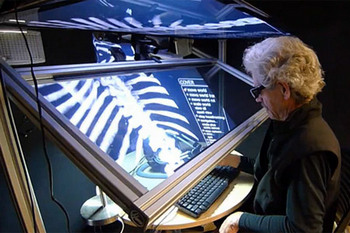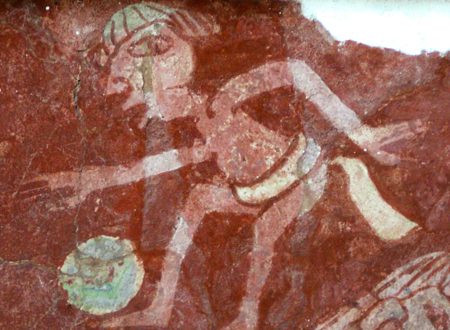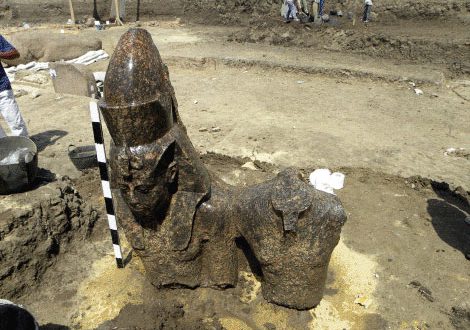 Some 400,000 years ago, Neanderthals diverged from the primate line that led to present-day humans. The Homo neanderthalis died out 30,000 years ago, while we managed to evolve into the handsomely built, technically skilled, and somewhat reasonable animal we are today. Research into Neanderthal DNA now shows that our extinct relatives did leave their mark in the genomes of some modern humans, leading researchers to believe that our species ‘paired up’ with our less evolutionary successful cousins when we were both living in the Middle East, about 100,000 to 50,000 years ago and before we left to populate Europe and Asia.
Some 400,000 years ago, Neanderthals diverged from the primate line that led to present-day humans. The Homo neanderthalis died out 30,000 years ago, while we managed to evolve into the handsomely built, technically skilled, and somewhat reasonable animal we are today. Research into Neanderthal DNA now shows that our extinct relatives did leave their mark in the genomes of some modern humans, leading researchers to believe that our species ‘paired up’ with our less evolutionary successful cousins when we were both living in the Middle East, about 100,000 to 50,000 years ago and before we left to populate Europe and Asia.
Neanderthals are the most recent, extinct relatives of modern humans. The current fossil records suggest they diverged from the primate line that led to the Homo sapiens some 400,000 years ago in Africa. Neanderthals then migrated north into Eurasia, where they became a geographically isolated group, evolving independent of the line that led to modern humans in Africa. They lived in Europe and western Asia, and Neanderthal remains have been found as far east as southern Siberia and as far south as the Middle East. Until 370,000 years later about 30,000 years or approximately 1500 generations ago they disappeared.
For comparison, another of our relatives, the chimpanzee not extinct yet, but endangered diverged from the same primate line some five to seven million years ago. Currently there are about half a million chimps populating Planet Earth, almost seven billion humans and zero Neanderthals.
In the last decades, controversy has surrounded the question of whether Neanderthals interbred with anatomically modern humans. Both physical properties of early man (derived from fossils) and DNA research have been used to argue both for and against an, errr, genetic contribution by Neanderthals towards the kind of animal we are today. Previous studies comparing Neanderthal and human mitochondrial DNA (mtDNA) have failed to provide a match, and thus evidence for interbreeding or ‘admixture’. However, this does not exclude the possibility of Neanderthal-on-human action, leading to Neanderthals contributing other parts of their genome to our present day genetic make-up.
Researchers have now produced the first whole Neanderthal sequence written as a succession of three billion letters using DNA samples from the bones of three female Neanderthals who lived and died at the Vindija Cave in Croatia some 40,000 years ago. The study was published in last week’s Science.
Complete Neanderthal Genome Sequenced
Working with ancient, sample-derived DNA is tough when compared with fresh samples, said Andy Bhattacharjee of Agilent’s Life Sciences Group. Thirty to forty thousand years have passed since Neanderthals walked on earth, and all that is left are ancient bones containing severely degraded DNA. The DNA itself has also undergone a sort of chemical aging, deamination.
Svante Pbo, Director of the Department of Evolutionary Genetics at the Max Planck Institute for Evolutionary Anthropology in Leipzig, says the main problem that arose when doing this was contamination by other organisms. Over 95 percent of the DNA in one sample originated from bacteria and microorganisms which colonized the Neanderthals after their death.
Therefore, removal of this contaminant DNA is of paramount importance, as this allows more coverage of the endogenous genome and therefore allows one to better decipher the genetic code. The capture methodology solves this big problem by enriching for Neanderthal sequences and depleting contaminant DNA. It’s an elegant solution, adds Bhattacharjee.
The method, published in the same May 2010 issue of the journal Science as the Neanderthal study, uses two rounds of ‘target enrichment’ procedure to enrich ancient DNA from rare and precious bone samples so it can be sequenced.
Another factor was human DNA, which could enter the samples during excavation or in the laboratory, jeopardizing the results. Various techniques were used to prevent this from influencing the results: each DNA fragment was marked with a short synthetic piece of DNA as a label, the samples were processed in ultra-clean rooms and various tests were run on the date to ensure contamination was minimized.
Comparing the draft Neanderthal genome sequence with the genetic sequence of humans and chimpanzees allows scientists to catalog the genetic differences. The researchers do so by identifying features that are unique to present-day humans and estimating when these mutations took place, as well as checking their findings against the fossil record for the evolution of hominins.
However, the new data suggests evolution did not proceed in a straight line. The diagram that shows how the different branches of hominins split off from one another that we were shown in high school might, as we suspected, just be too simplistic. Rather, evolution appeared to be a messier process, with emerging species merging back into the lines from which they diverged.
The comparison of these two genetic sequences enables us to find out where our genome differs from that of our closest relatives, said Svante Pbo.
Cataloging What Makes us Human

By comparing the Neanderthal and modern genetic sequences, researchers have tried to discover genes that distinguish modern humans from their close relatives and which may have given us certain advantages over the course of evolution. For example, the catalogue includes differences in genes that code for functional elements, such as proteins, in which the Neanderthal versions are more like those of the chimpanzee than present-day humans. Some evolutionary changes were found in genes involved in cognitive development, skull structure, energy metabolism, skin morphology and wound healing.
This was done by identifying sites in the genome alignment where the human genome sequence which was decoded about ten years ago does not match that of chimpanzee, orangutan or rhesus macaque and are likely to have changed since the ancestor we shared with chimps and then comparing these to the Neanderthal DNA.
Two notable genes that emerged from the results are a gene influencing the pigmentation of the skin, and differences in genetic make-up that could affect aspects of energy metabolism how effectively mammoth steak is rendered into human action.
Another gene that differs is RUNX2. When affected in the Homo sapiens (that’s us!) it can cause a series of abnormalities, which can easily be associated with the Neanderthal physique: a bell-shaped rib cage, a more prominent cranial frontal bone and differences in the architecture of the shoulder joint. It is thus reasonable to assume that an evolutionary change in this gene was of importance to the origin of modern humans.
The Neanderthal in you
The study found Neanderthals are equally close to Europeans and East-Asians, but significantly closer to non-Africans than to Africans. The Neanderthal exchanged genes with ancestors of non-Africans, more particular, the researchers concluded that the gene flow was from Neanderthal into modern humans.
A 2009 study estimated the amount of non-African genomes affected by gene flow from ‘archaic’ hominids, including Neanderthals, to be 14%, however Pbo’s team claim that this figure is over-estimated. They conclude that between 1 to 4% of ‘Eurasian DNA’ is derived from Neanderthal.
Thus the genomic data seems to suggest that Neanderthals re-encountered anatomically modern humans, who began migrating out of Africa some 80,000 years ago. When we were leaving Africa in small pioneering groups, we must have encountered of the seventh kind a bunch of Neanderthals living in the Fertile Crescent of the Middle East, before the human population spread across East Asia.
The study does stipulate that the actual amount of interbreeding between Neanderthal and modern humans may have been very limited, given that it only contributed to 1 to 4% of the genome of present-day non-Africans.
It was a very unique series of events, with a founding population of modern humans of greatly reduced size tens to hundreds of individuals, Jim Mullikin commented. Geneticists can detect a population constriction or bottleneck where certain genetic markers are concentrated; that only occurs when the population is small. At that time, Dr Mullikin continued, where the population was greatly reduced, the modern humans migrating out of Africa encountered Neanderthals and interbreeding occurred between the two groups, leaving an additional, but subtle, genetic signature in the out-of-Africa group of modern humans.
The researchers have not yet detected any signs that the DNA from modern humans can be found in the Neanderthal genome. Neither is it known whether a more systematic sampling of African populations will reveal the presence of Neanderthal DNA in some indigenous Africans.
These are preliminary data based on a very limited number of samples, so it is not clear how widely applicable these findings are to all populations, said Vence Bonham. The findings do not change our basic understanding that humans originated in Africa and dispersed around the world in a migration out of that continent.
So nothing is ‘really’ certain, yet again. But don’t let that put you off: the methodology developed during these studies can also be applied to other challenging studies in paleontology and archaeology as well as other human forensics. And having overcome multiple technical challenges, the scholars look optimistically into the future: We will also decode the remaining parts of the Neanderthal genome and learn much more about ourselves and our closest relatives, said Svante Pbo.
This did lead to an entertaining challenge over the weekend: explaining all this over a pint, and accurately estimating the amount of Neanderthal (or other primitive hominins) DNA in the specimens of male Homo sapiens we observed or interacted with. The conclusion was that this study must still underestimate the amount of DNA the more primitive hominids have contributed, unless they did not take alcohol intoxication of said specimens into account. We’d also appreciate a heads up on any more research into a) if ‘addiction’ is mapped into our genes or rather a Pavlov effect (fruits beyond conservation date make me merry, so I’ll consume more) and b) spatial awareness, in particular, theoretically, whether a monkey can learn to beat a human at foosball?















